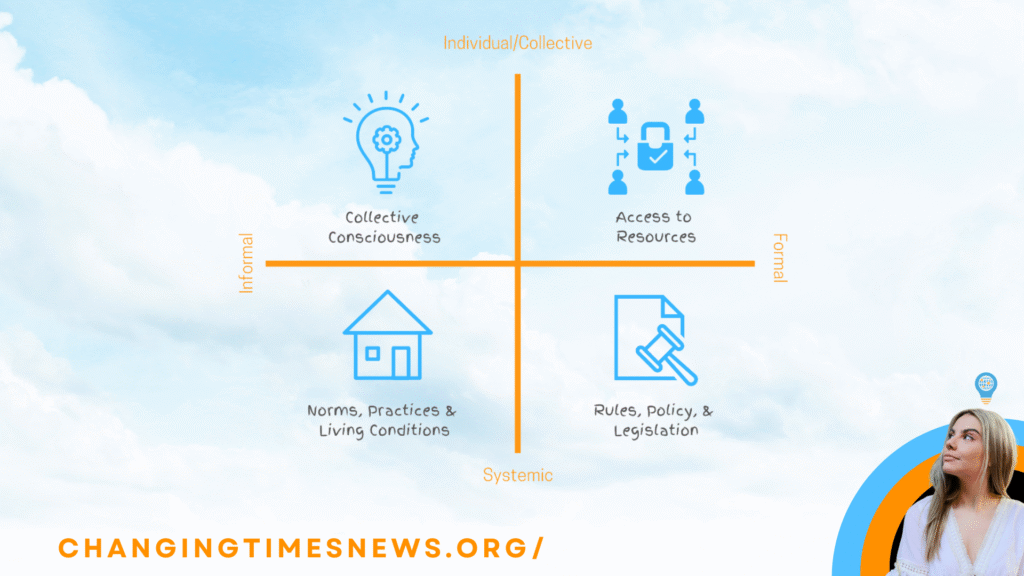In a world defined by rapid disruption—from climate crises to social inequality—the old models of “progress” are showing their cracks. In this week’s Changemaker Q&A, host and social impact researcher Tiyana J explores why it’s time to move beyond linear models of change—and how a nonlinear approach could help us tackle complex, interconnected challenges more effectively.
Drawing from her presentation at the Research for Development Impact (RDI) Network Conference in Sydney, Tiyana J argues that the way modern societies have learned to think about change—step-by-step, mechanical, and linear—simply doesn’t align with how change actually happens. “We tend to think about change as something that moves along a timeline,” she explains in the episode. “But change isn’t a sequence of events—it’s a continuous unfolding.”
This idea, rooted in systems thinking and complexity theory, challenges the Enlightenment-era worldview that still dominates much of Western thought. Thinkers like René Descartes helped lay the foundations for scientific progress, but their focus on reductionism—breaking the world down into parts—has also led us to overlook the dynamic interconnections that define living systems.
As Tiyana J notes, many Indigenous and ancient knowledge systems have long emphasized these interconnections. Their holistic approaches to understanding the world echo the language of today’s complexity science, which recognizes that social, ecological, and economic systems evolve through constant interaction and adaptation rather than linear cause-and-effect.
From Linear Progress to Dynamic Unfolding
In her doctoral research, Tiyana J describes change as a “dynamic unfolding”—a process in which some elements of reality persist (continuity), others fade away (discontinuity), and new features emerge (emergence). Every moment of transformation, whether in an ecosystem, an organization, or a society, is composed of these three dimensions.
This view invites changemakers to stop seeing social transformation as a series of discrete steps—like policy interventions, project timelines, or “before-and-after” outcomes—and start seeing it as a living process. “When we understand change as something ongoing and relational,” she says, “we can design interventions that work with the nature of change, not against it.”
Her framework also offers a practical guide for anyone working in social innovation or sustainable development. Before designing a project, Tiyana J suggests asking three questions:
- What do we want to continue?
- What do we want to discontinue?
- What do we want to emerge?
By applying these questions, changemakers can build a clearer picture of the systems they’re influencing—and ensure their efforts support resilience rather than reinforcing instability.
Rethinking Development and Resilience
Tiyana J also challenges how we define development itself. The concept, she argues, has often been framed through a colonial, extractive, and linear lens—one that measures success by moving from “underdeveloped” to “developed.” But societies, unlike individuals, don’t grow along a single timeline with fixed milestones.
Instead, she proposes resilience as a more accurate framework for understanding social progress. Not resilience in the “bounce back” sense familiar in disaster management, but as the capacity to engage with and shape change across all three dimensions: continuity, discontinuity, and emergence.
“Resilience,” she explains, “isn’t a trait we possess—it’s a relationship we cultivate.” It’s about stabilizing what matters, adapting to new conditions, and transforming systems when necessary. This triad—stabilize, adapt, transform—could become a guiding logic for sustainable development in a world where stability and change must coexist.
This approach echoes the resilience thinking emerging from ecological science, where systems are seen as dynamic, self-organizing, and adaptive. Researchers like C.S. Holling and the Stockholm Resilience Centre have long emphasized that thriving ecosystems maintain stability precisely because they are always changing (Stockholm Resilience Centre, 2024).
Change as a Living System
The metaphor of an ecosystem runs throughout Tiyana J’s thinking. Just as a forest can simultaneously preserve soil systems, adapt to shifting climates, and foster new growth, human societies must hold space for continuity, adaptation, and transformation all at once.
In policy, this could mean designing programs that protect community values while also enabling innovation. In sustainability, it might mean coupling conservation with regeneration. And in leadership, it means moving away from rigid plans toward learning-based, feedback-driven approaches.
“We’re making things harder for ourselves,” she notes, “when we approach change in a way that doesn’t reflect its true nature.”
As the pace of global transformation accelerates, embracing nonlinearity might not just be an intellectual exercise—it could be a survival strategy.


